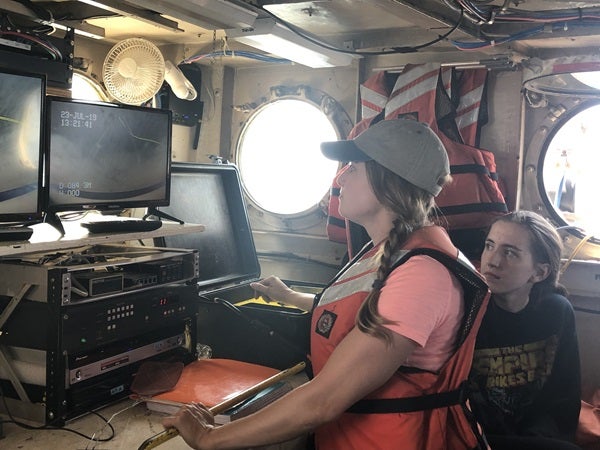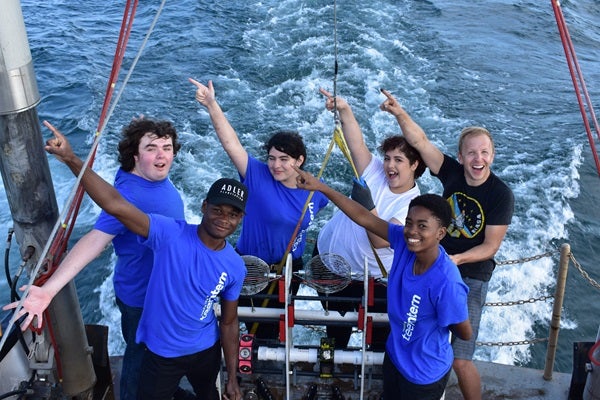The Aquarius Project — led by Chicago’s Adler Planetarium, which partnered with NASA and other Chicago institutions: the Field Museum and Shedd Aquarium — aims to recover pieces of that rock from the bottom of the lake. But the project is also much more. It’s the first time these institutions have all worked together on a single project. And the project also provides local teenagers with the opportunity to experience innovation and collaboration as they work toward a scientific goal.
A unique undertaking
Only one other project, called Nautilus, has attempted underwater meteorite recovery. But Nautilus was a collaboration of professional institutions and researchers only, who pulled pieces of a meteorite from seawater off the coast of Washington state just months after it fell.
By contrast, Aquarius’ meteorite-hunting sled, RV Starfall, was designed and built by Adler Planetarium teen interns. Nearly every part of the sled is repurposed: Its meteorite-seeking magnets are affixed to cartridges from a 3D printer, while much of the sled’s frame is made from material removed from the Shedd Aquarium’s kitchen during renovations. Still other pieces of the frame are repurposed from defunct Adler exhibits.
The sled is also operated by teen interns, accompanied by Adler staff and other researchers. Two years later, they continue to search for meteorite fragments in Lake Michigan. More time underwater — and in freshwater conditions — means that whatever they ultimately recover will differ from Nautilus’ haul. And whether or not pieces of an alien world are pulled from the water, the Aquarius Project is already making new discoveries at the bottom of Lake Michigan.
As it scours the lakebed, pulled behind the University of Wisconsin-Milwaukee research ship Neeskay, the Starfall sled is designed to gather material that fell from space. But it also collects valuable data on the conditions in the lake.
And those observations have unveiled surprises. Although parts of Lake Michigan have been mapped in great detail, the area where Starfall is exploring, off the coast of Manitowoc, Wisconsin, has not. “We were literally the first people to see what was down there, the first explorers to venture there,” marine biologist and Adler volunteer Philip Willink wrote in project document.
Additionally, the bottom of the lake looks almost star-studded itself in the sled’s video feed. But the “stars” are actually fingernail-sized quagga mussels, which virtually coat the bottom of the lake. The team expected to see the mussels in scattered patches, but instead discovered they coat virtually every inch of the lakebed. Patches without mussels are rare, Willink says.
But it’s not just what the team sees at the bottom of the lake that aids environmental studies of the area. It’s what they hope to bring up, as well. The condition of any meteorites Starfall collects will reveal clues about their underwater home for the past two years.
“That’s one of the big motivators of the project,” Willink explains. “We know exactly how long the meteorites have been down there.” So, recovering samples that have been at the bottom of the lake offers a unique window into the conditions deep beneath the surface, he says. Studying the meteorite samples will also tell researchers how meteorites weather in freshwater over years, which has never been previously studied because no samples have ever been recovered. This information would aid efforts to recover more meteorites from lakebeds by bringing to light just how the watery environment affects space rocks over time.
Anatomy of a meteorite hunt
Each excursion is a chance to test out new design ideas or search strategies. When I embarked with the Aquarius team in late July, the group was adjusting the sled right up until it was ready to deploy in the water.
We launched near the top of the strewn field, which is the area where pieces of meteorite can be found. The heaviest pieces fell closest to shore, while lighter, smaller pieces are farther out in the lake. That’s because when the object exploded overhead, the largest pieces felt the least amount of drag from the air and simply kept going, plunking down furthest from the explosion.
Large pieces, while perhaps more easily identifiable, are likely few and far between. That makes them enticing targets but extremely resource-intensive to find. The smallest pieces, which Starfall is after, were carried by the wind, falling elsewhere in the lake. Because they’re smaller and essentially fell into the lake as a cloud, there should be more of them located closer together.
Once at the search zone, visiting staff from the University of Wisconsin-Milwaukee’s School of Freshwater Sciences sampled water and material from the bottom of the lake, where the temperature is roughly 39 degrees Fahrenheit (4 degrees Celsius). Deploying Starfall itself was a careful process. The cable for the sled’s cameras and sensors must be slowly fed out and zip-tied to the line towing the craft to avoid tangling. Finally, the sled reached the bottom of the lake, some 260 feet (80 meters) below, and the search began. It was the deepest the sled had gone yet.
As the Neeskay pulls Starfall along at a crawl, the sled’s three magnetic wheels — designed to attract weakly magnetic meteoritic material roughly pea-sized or smaller — pull up anything of interest. Those magnets are so strong the sled actually sticks to the metallic deck of the boat, and sometimes material must be pried off with a flathead screwdriver. “Don’t get your cell phones or credit cards too close,” Willink jokes.
There are pitfalls. The sled’s strong magnets attract anything magnetic, so there are plenty of interlopers, like natural magnetite and human-made slag, the waste created during ore extraction and refining. These materials can sometimes appear meteorite-like, although they are often easy to dismiss on first pass. Meteorites generally have rounded edges that result of friction and heating within the atmosphere. That same heating also typically forms a fusion crust, the dark shell that surrounds the lighter material within. The absence of these two features typically eliminates any find from the running, though the team is careful not to dismiss anything too quickly.
The team hoses down the sled onto the sheet, then removes any material still stuck to the magnets by hand. Larger pieces that look promising are separated into Tupperware containers, while the sled is hauled upright so the sheet can be removed, excess water squeezed through it like a cheesecloth, and the remaining material bundled away into a bucket.
During the second and final run of the day, the sled bumped into something that appeared to be a discarded tire. Recording the coordinates where it happened, “This project is telling us a lot about what we’ve been dumping in the lake,” Willink notes. Once the sled was pulled up, we also noticed one of the beater-like attachments at the back of the sled had gone missing, though Willink says this is a common occurrence.
Science for everyone
There are some very promising “maybes.” But even if the Aquarius Project never recovers pieces of the meteorite, the team thinks it has already been a resounding success, says Adler Teen Programs Manager Chris Bresky. It’s allowed teens the chance to take on, from scratch, a never-before-attempted scientific project with far-reaching benefits, from local conservation and freshwater ecology to solar system science.
The project was awarded a 2018 Chicago Innovation Award, and is the subject of an ongoing Adler Planetarium podcast that has followed the team from its earliest conception. And recently, the Aquarius Project was featured in a talk and will become an exhibit at the Wisconsin Maritime Museum.
The Aquarius Project is helping dedicated researchers and conservationists better understand one of the United States’ largest freshwater lakes. It’s teaching teens how collaboration in science works. And, once pieces of the meteorite are confirmed, the undertaking could open the door to cost-efficient recovery of many more meteorites — a definite win for planetary scientists with a limited supply to study.














